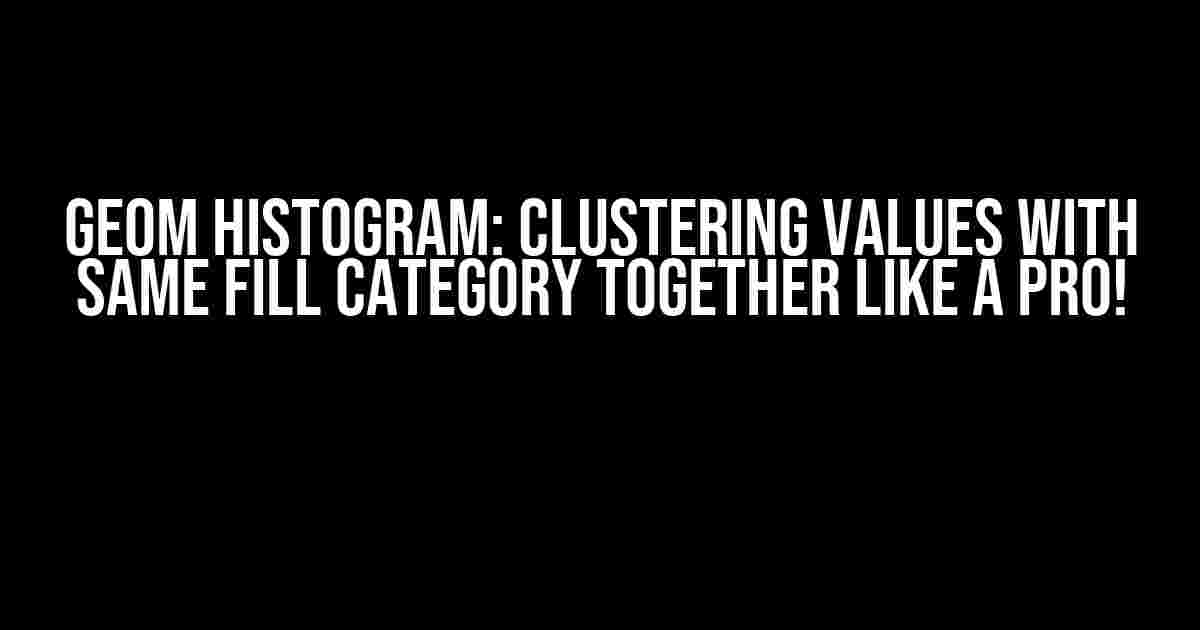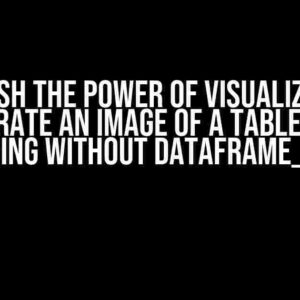Are you tired of looking at messy and confusing histograms? Do you want to elevate your data visualization game and present your geom histogram in a more organized and meaningful way? If yes, then you’re in the right place! In this article, we’ll show you how to cluster values with the same fill category together in a geom histogram, making it easier to analyze and understand your data.
What is a Geom Histogram?
A geom histogram is a type of graph used to visualize the distribution of continuous data. It’s similar to a bar chart, but instead of discrete categories, it shows the frequency or density of the data points within a range of values. Geom histograms are particularly useful when you want to see the underlying structure of your data, such as patterns, outliers, and clusters.
Why Cluster Values with Same Fill Category Together?
When you have a geom histogram with multiple fill categories, it can be challenging to identify patterns and relationships between the data points. By clustering values with the same fill category together, you can:
- Improve the visual appeal of your histogram
- Enhance the comparison between different fill categories
- Identify clusters and patterns more easily
- Reduce visual noise and make the histogram more readable
Preparing Your Data
Before we dive into the code, make sure you have the following:
- A dataset with continuous values (e.g., values, scores, ratings)
- A categorical variable for the fill category (e.g., groups, categories, labels)
- The ggplot2 package installed in R (if you’re using R)
Data Example
# Sample dataset
df <- data.frame(
values = c(1, 2, 3, 4, 5, 6, 7, 8, 9, 10),
category = c("A", "B", "A", "B", "A", "B", "A", "B", "A", "B")
)
The Magic Happens
Now, let’s create a geom histogram with clustered values using the same fill category:
# Load ggplot2 library(ggplot2) # Create the geom histogram ggplot(df, aes(x = values, fill = category)) + geom_histogram(binwidth = 1, color = "black", alpha = 0.5) + scale_fill_discrete(name = "Category") + theme_classic()
What’s Happening in the Code
In the code above, we:
- Map the
valuescolumn to the x-axis and thecategorycolumn to the fill aesthetic - Use
geom_histogram()to create the histogram, specifying the binwidth and color - Add a discrete fill scale with a custom name
- Apply a classic theme to improve readability
Clustering Values with Same Fill Category Together
To cluster values with the same fill category together, we’ll use the position_stack() function:
# Create the geom histogram with clustered values ggplot(df, aes(x = values, fill = category)) + geom_histogram(binwidth = 1, color = "black", alpha = 0.5, position = "stack") + scale_fill_discrete(name = "Category") + theme_classic()
What’s Changed?
In the updated code, we added the position = "stack" argument to the geom_histogram() function. This tells ggplot2 to stack the histogram bars by the fill category, effectively clustering values with the same category together.
Customizing the Appearance
You can further customize the appearance of your geom histogram by adjusting the:
- Binwidth: Change the width of the histogram bars
- Alpha: Adjust the transparency of the histogram bars
- Color: Modify the color of the histogram bars
- Theme: Apply different themes to change the overall appearance
# Customize the appearance
ggplot(df, aes(x = values, fill = category)) +
geom_histogram(binwidth = 0.5, color = "black", alpha = 0.7, position = "stack") +
scale_fill_discrete(name = "Category") +
theme_classic() +
theme(
panel.grid.major = element_line(size = 0.5, color = "gray"),
axis.text = element_text(size = 12)
)
Conclusion
And that’s it! You now have a geom histogram with clustered values using the same fill category. By following these steps, you can create visually appealing and informative histograms that help you uncover patterns and relationships in your data.
Final Tips
- Experiment with different binwidths to find the optimal value for your data
- Use different colors and themes to highlight specific patterns or trends
- Consider using faceting or grouping to create more detailed and nuanced visualizations
| Keyword | Explanation |
|---|---|
| Geom Histogram | A type of graph used to visualize the distribution of continuous data |
| Fill Category | A categorical variable used to color the histogram bars |
| Position Stack | A function used to cluster values with the same fill category together |
By mastering the art of clustering values with the same fill category together in a geom histogram, you’ll be able to create more effective and engaging data visualizations that drive insights and discovery.
Frequently Asked Question
Get ready to geek out with us as we dive into the world of geom_histogram clustering! 📈
What is the main goal of clustering values with the same fill category together in geom_histogram?
The primary goal is to visualize and group similar data points together based on their fill category, making it easier to identify patterns and trends within the histogram.
How does clustering values with the same fill category improve data visualization in geom_histogram?
By clustering values with the same fill category together, geom_histogram creates a more organized and structured visualization, allowing viewers to quickly distinguish between different categories and focus on the most important data insights.
What type of data is best suited for clustering values with the same fill category together in geom_histogram?
Categorical data, such as categorical variables or grouped data, is ideally suited for clustering values with the same fill category together in geom_histogram, as it allows for meaningful grouping and comparison of data points.
Can I customize the appearance of the clustered values in geom_histogram?
Yes, you can customize the appearance of the clustered values in geom_histogram by using various aesthetic mappings, such as color, shape, and size, to differentiate between categories and create a visually appealing plot.
What are some common use cases for clustering values with the same fill category together in geom_histogram?
Common use cases include analyzing customer demographics, comparing product sales by region, and visualizing survey responses by category, among others. Clustering values with the same fill category together helps to identify trends and patterns that might be hidden in the data.


